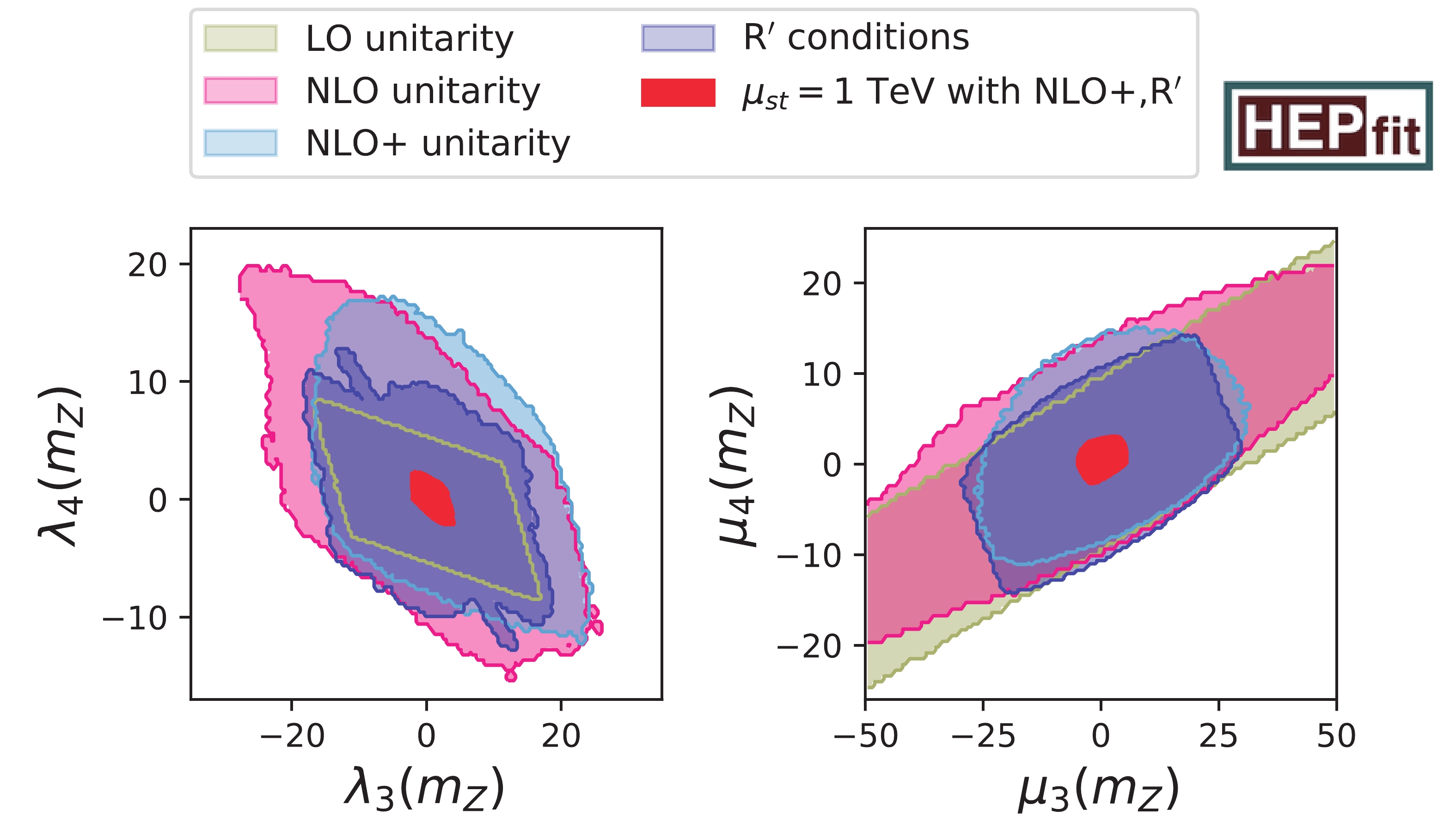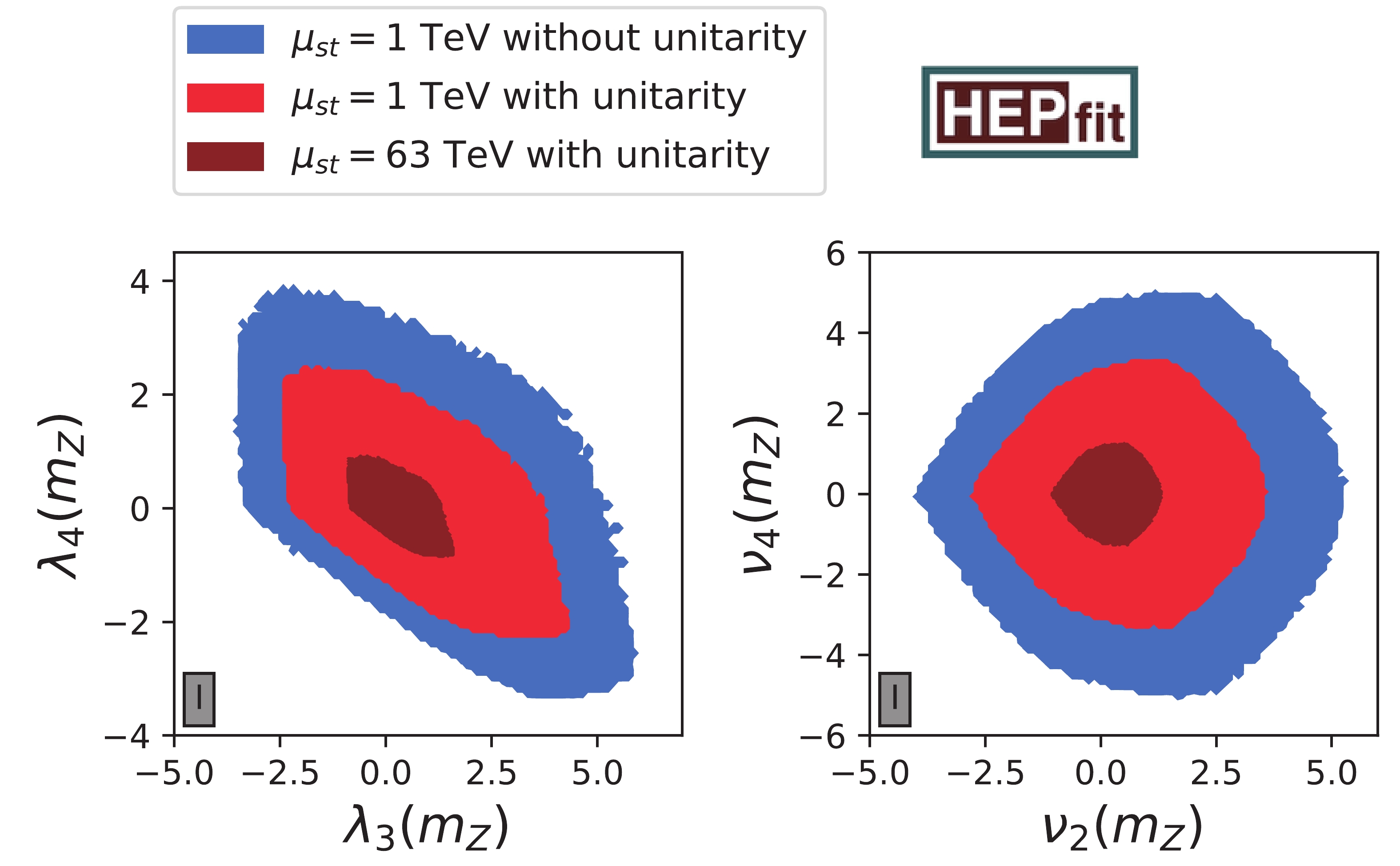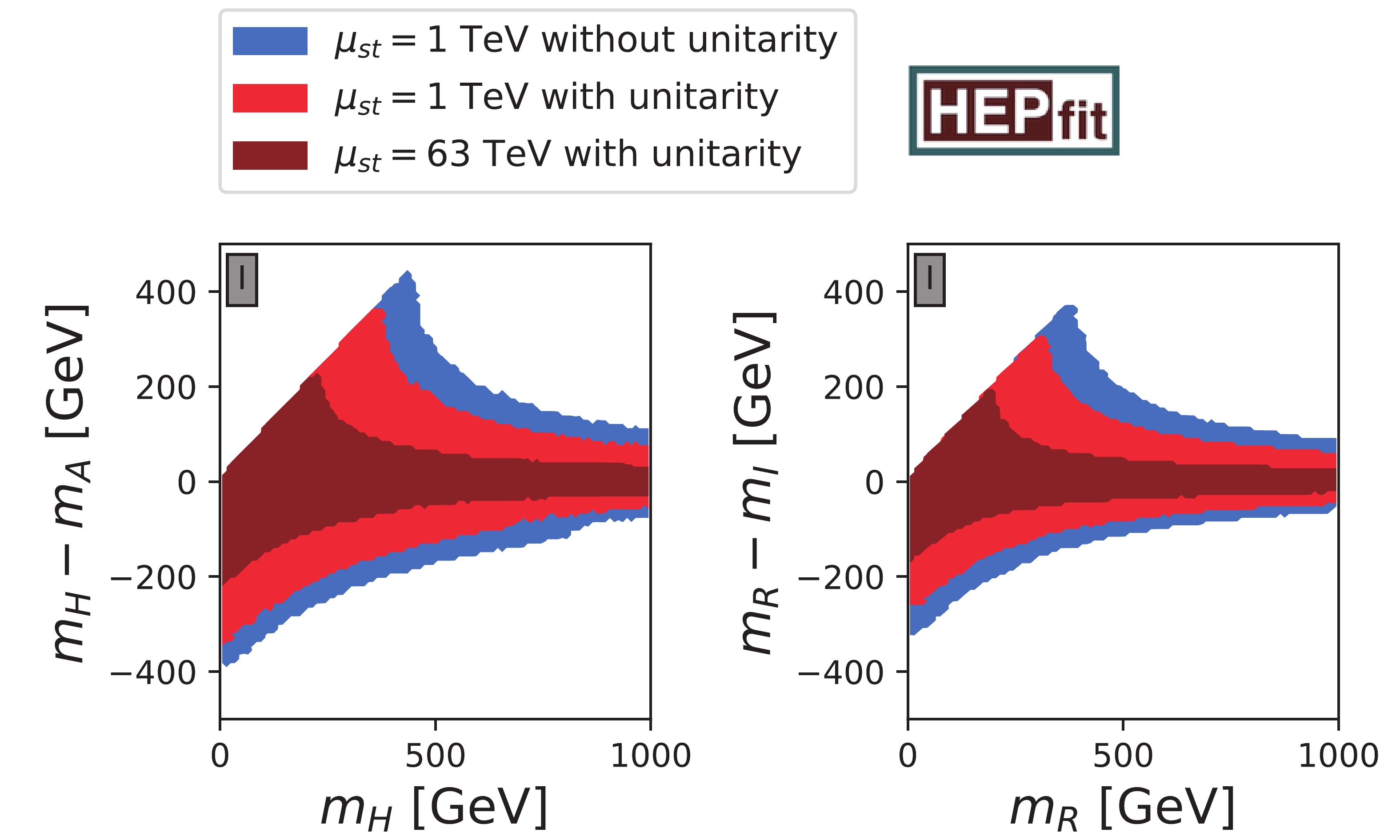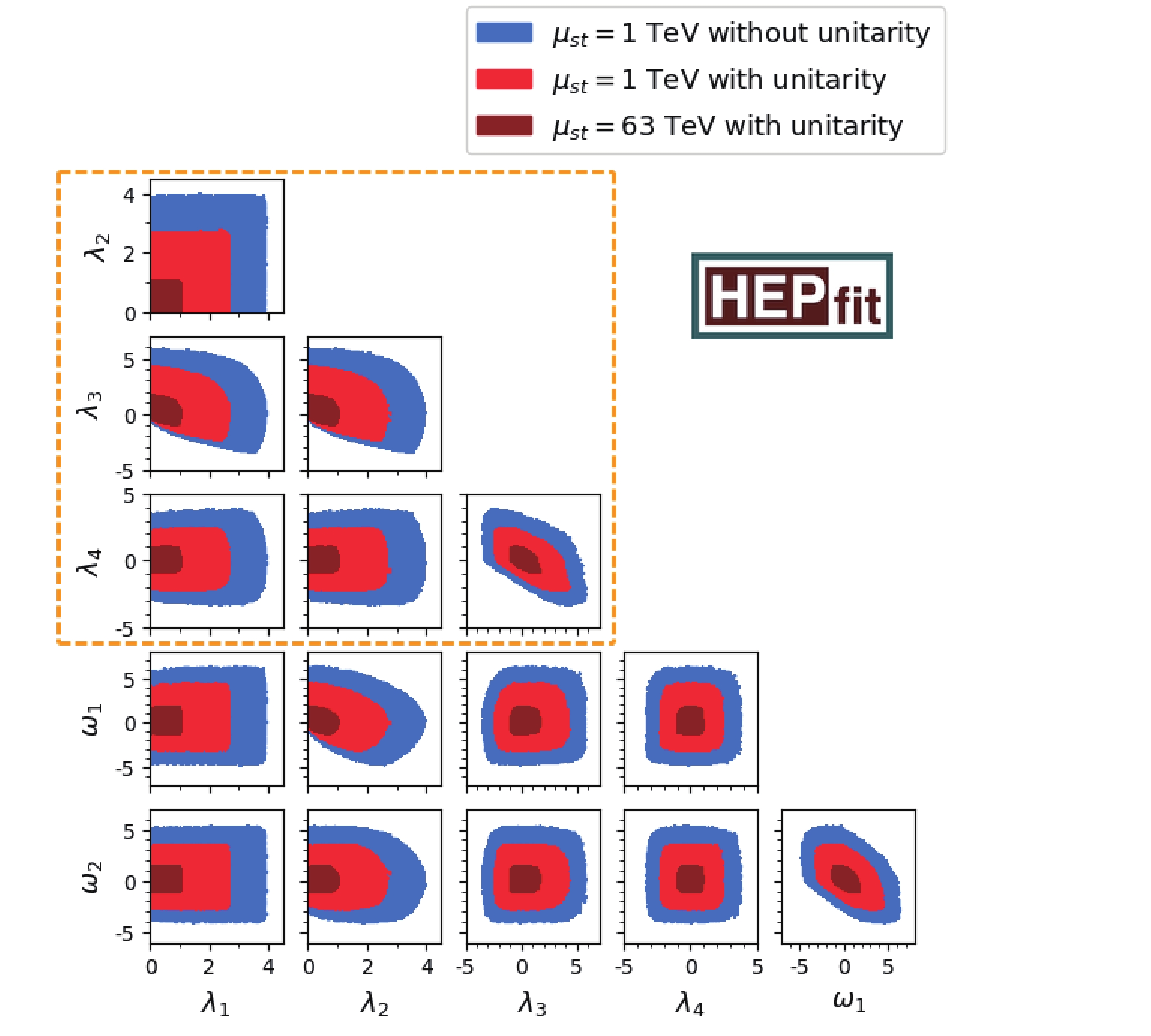HTML
--> --> -->Combining the above motivations, Refs. [18, 19] recently proposed a new model containing aspects of both the MW model and 2HDM. In particular, the scalar sector of the model in consideration consists of two color-singlet electroweak doublets,
Ref. [18] investigated tree-level constraints on the 2HDMW arising from symmetries and perturbative unitarity. A study of LHC phenomenology was also performed, which found that the color-octet scalar added to the 2HDM could produce large corrections to the one-loop couplings of the Higgs boson to two gluons or photons. The study presented in Ref. [19] derived the one-loop beta functions for the scalar couplings in the 2HDMW, and the evolution of the renormalization group equations (RGEs) was then used to place upper limits on the parameters of the model. Similar practices were applied in studies of the the SM [23, 24], MW model [14], and the 2HDM [25–27]. The parameter space was further constrained in Ref. [19] by requiring no Landau poles (LPs) below a certain high-energy scale Λ, the scalar potential being stable and the perturbative unitarity being satisfied at all scales below Λ. The perturbative unitarity constraints imposed on the model in Refs. [18, 19] are of the leading order (LO), and a considerable region in the parameter space survives.
Although instructive, the preceding studies on constraints imposed on the 2HDMW are not yet comprehensive. It is a reasonable expectation that supplementing corrections at higher orders can result in noticeable modifications to the surviving parameter space. However, the behavior of higher order corrections is usually complicated. There is no simple answer to whether their impact is to tighten or relax the viable ranges of couplings. In this study, we utilize the generic tool provided by Refs. [28–30] to explore these perturbative unitarity bounds at next-to-leading order (NLO) and first impose them on color-octet scalar. However, the positivity conditions are only known for 2HDM. Taking an additional color-octet into account, one should reconsider the scalar potential as a whole and secure the existence of the global minimum. Completely solving this problem is extremely challenging. This study is also the first work to expand the set of positivity conditions to both MW and 2HDMW models.
Generally, this work focuses on theoretical constraints of the 2HDMW. An investigation of experimental bounds of the model will be performed in a future study. The rest of the paper is organized as follows: the 2HDMW model is defined in Sec. 2. The theoretical constraints are explained in Sec. 3. Followingly, our results for the surviving parameter space are presented in Sec. 4. Concluding remarks are provided in Sec. 5.
$ \begin{split}V_{\rm{gen}}\! =& m_{11}^2\Phi_1^\dagger\Phi_1^{\phantom{\dagger}} \! +\! m_{22}^2\Phi_2^\dagger\Phi_2^{\phantom{\dagger}} \! -\! m_{12}^2 \left( \Phi_1^\dagger\Phi_2^{\phantom{\dagger}} \!+\!\Phi_2^\dagger\Phi_1^{\phantom{\dagger}}\right) \! +\! \displaystyle\frac{1}{2} \lambda_1\left(\Phi_1^\dagger\Phi_1^{\phantom{\dagger}}\right)^2 \\& + \displaystyle\frac{1}{2} \lambda_2\left(\Phi_2^\dagger\Phi_2^{\phantom{\dagger}}\right)^2 \! +\! \lambda_3 \left(\Phi_1^\dagger\Phi_1^{\phantom{\dagger}}\right) \left(\Phi_2^\dagger\Phi_2^{\phantom{\dagger}}\right) \! +\! \lambda_4 \left(\Phi_1^\dagger\Phi_2^{\phantom{\dagger}}\right) \left(\Phi_2^\dagger\Phi_1^{\phantom{\dagger}}\right) \\&+ \displaystyle\frac{1}{2} \left[ \lambda_5 \left(\Phi_1^\dagger\Phi_2^{\phantom{\dagger}}\right)^2 + {\rm h.c.} \right] + \left[ \lambda_6 \left( \Phi_1^\dagger\Phi_1^{\phantom{\dagger}} \right) \left( \Phi_1^\dagger\Phi_2^{\phantom{\dagger}} \right) \right. \\& \left. +\lambda_7 \left( \Phi_2^\dagger\Phi_2^{\phantom{\dagger}} \right) \left( \Phi_1^\dagger\Phi_2^{\phantom{\dagger}} \right) + {\rm h.c.} \right] + 2 m_S^2 {\rm Tr}\left(S^{\dagger i} S^{\phantom{\dagger}}_i\right) \\ & + \mu_1 {\rm Tr}\left(S^{\dagger i} S^{\phantom{\dagger}}_i S^{\dagger j} S^{\phantom{\dagger}}_j\right) + \mu_2 {\rm Tr}\left(S^{\dagger i} S^{\phantom{\dagger}}_j S^{\dagger j} S^{\phantom{\dagger}}_i\right) \\ & + \mu_3 {\rm Tr}\left(S^{\dagger i} S^{\phantom{\dagger}}_i\right) \left(S^{\dagger j} S^{\phantom{\dagger}}_j\right) + \mu_4 {\rm Tr}\left(S^{\dagger i} S^{\phantom{\dagger}}_j\right) \left(S^{\dagger j} S^{\phantom{\dagger}}_i\right) \\ & + \mu_5 {\rm Tr}\left(S^{\phantom{\dagger}}_i S^{\phantom{\dagger}}_j\right) \left(S^{\dagger i} S^{\dagger j}\right) + \mu_6 {\rm Tr}\left(S^{\phantom{\dagger}}_i S^{\phantom{\dagger}}_j S^{\dagger j} S^{\dagger i}\right) \\ & + \nu_1 \Phi_1^{\dagger i}\Phi_{1i}^{\phantom{\dagger}} {\rm Tr}\left(S^{\dagger j} S^{\phantom{\dagger}}_j\right) + \nu_2 \Phi_1^{\dagger i}\Phi_{1j}^{\phantom{\dagger}} {\rm Tr}\left(S^{\dagger j} S^{\phantom{\dagger}}_i\right) \\ & +\left[ \nu_3 \Phi_1^{\dagger i}\Phi_1^{\dagger j} {\rm Tr}\left(S^{\phantom{\dagger}}_i S^{\phantom{\dagger}}_j\right) +\nu_4 \Phi_1^{\dagger i} {\rm Tr}\left(S^{\dagger j} S^{\phantom{\dagger}}_j S^{\phantom{\dagger}}_i\right) \right. \\ &\left.+\nu_5 \Phi_1^{\dagger i} {\rm Tr}\left(S^{\dagger j} S^{\phantom{\dagger}}_i S^{\phantom{\dagger}}_j\right) + {\rm h.c.}\right] + \omega_1 \Phi_2^{\dagger i}\Phi_{2i}^{\phantom{\dagger}} {\rm Tr}\left(S^{\dagger j} S^{\phantom{\dagger}}_j\right) \\ & + \omega_2 \Phi_2^{\dagger i}\Phi_{2j}^{\phantom{\dagger}} {\rm Tr}\left(S^{\dagger j} S^{\phantom{\dagger}}_i\right) +\left[ \omega_3 \Phi_2^{\dagger i}\Phi_2^{\dagger j} {\rm Tr}\left(S^{\phantom{\dagger}}_i S^{\phantom{\dagger}}_j\right)\right. \\ &\left.+\omega_4 \Phi_2^{\dagger i} {\rm Tr}\left(S^{\dagger j} S^{\phantom{\dagger}}_j S^{\phantom{\dagger}}_i\right) +\omega_5 \Phi_2^{\dagger i} {\rm Tr}\left(S^{\dagger j} S^{\phantom{\dagger}}_i S^{\phantom{\dagger}}_j\right) +{\rm h.c.}\right] \\ &+\left[ \kappa_1 \Phi_1^{\dagger i} \Phi_{2i}^{\phantom{\dagger}} {\rm Tr}\left(S^{\dagger j} S^{\phantom{\dagger}}_j\right) +\kappa_2 \Phi_1^{\dagger i} \Phi_{2j}^{\phantom{\dagger}} {\rm Tr}\left(S^{\dagger j} S^{\phantom{\dagger}}_i\right) \right. \\ &\left.+\kappa_3 \Phi_1^{\dagger i} \Phi_2^{\dagger j} {\rm Tr}\left(S^{\phantom{\dagger}}_j S^{\phantom{\dagger}}_i\right) +{\rm h.c.}\right] . \end{split} $  | (1) |
The physical parameters of this model are the masses of the
We apply the following conditions to reduce the number of parameters in the scalar potential and the Yukawa potential, defined below in Eq. (2) and Eq. (3), respectively.
● We restrict the 2HDM sector to be CP-conserving.
● Custodial symmetry [32–34]: We adopt the less restrictive method discussed in [18]. The mass degeneracies
● We impose a
| Φ1 | Φ2 | S | UR | DR | QL | |
| Type I | ? | + | ? | ? | ? | + |
| Type IIu | ? | + | ? | ? | + | + |
| Type IId | ? | + | + | ? | + | + |
Table1.
The scalar potential of the model with the aforementioned imposed constraints reads:
$ \begin{split}V_{{\rm {fit}}} =& m_{11}^2\Phi_1^\dagger\Phi_1^{\phantom{\dagger}} \!+\! m_{22}^2\Phi_2^\dagger\Phi_2^{\phantom{\dagger}} \!-\! m_{12}^2 \left( \Phi_1^\dagger\Phi_2^{\phantom{\dagger}} \!+\!\Phi_2^\dagger\Phi_1^{\phantom{\dagger}}\right) \! +\! \displaystyle\frac{1}{2} \lambda_1\left(\Phi_1^\dagger\Phi_1^{\phantom{\dagger}}\right)^2 \\& + \displaystyle\frac{1}{2} \lambda_2\left(\Phi_2^\dagger\Phi_2^{\phantom{\dagger}}\right)^2 + \lambda_3 \left(\Phi_1^\dagger\Phi_1^{\phantom{\dagger}}\right) \left(\Phi_2^\dagger\Phi_2^{\phantom{\dagger}}\right) + \displaystyle\frac{1}{2} \lambda_4 \left[ \left(\Phi_1^\dagger\Phi_2^{\phantom{\dagger}}\right) \right. \\ & \left. + \left(\Phi_2^\dagger\Phi_1^{\phantom{\dagger}}\right) \right]^2 + 2 m_S^2 {\rm Tr}\left(S^{\dagger i} S^{\phantom{\dagger}}_i\right) + \mu_1 \left[ {\rm Tr}\left(S^{\dagger i} S^{\phantom{\dagger}}_i S^{\dagger j} S^{\phantom{\dagger}}_j\right) \right. \\ & \left.+{\rm Tr}\left(S^{\dagger i} S^{\phantom{\dagger}}_j S^{\dagger j} S^{\phantom{\dagger}}_i\right) +2 {\rm Tr}\left(S^{\phantom{\dagger}}_i S^{\phantom{\dagger}}_j S^{\dagger j} S^{\dagger i}\right) \right] \\ & + \mu_3 {\rm Tr}\left(S^{\dagger i} S^{\phantom{\dagger}}_i\right) \left(S^{\dagger j} S^{\phantom{\dagger}}_j\right) + \mu_4 \left[ {\rm Tr}\left(S^{\dagger i} S^{\phantom{\dagger}}_j\right) \left(S^{\dagger j} S^{\phantom{\dagger}}_i\right) \right. \\ & \left. + {\rm Tr}\left(S^{\phantom{\dagger}}_i S^{\phantom{\dagger}}_j\right) \left(S^{\dagger i} S^{\dagger j}\right) \right] + \nu_1 \Phi_1^{\dagger i}\Phi_{1i}^{\phantom{\dagger}} {\rm Tr}\left(S^{\dagger j} S^{\phantom{\dagger}}_j\right) \\ &+\displaystyle\frac{1}{2} \nu_2 \left[ \Phi_1^{\dagger i}\Phi_{1j}^{\phantom{\dagger}} {\rm Tr}\left(S^{\dagger j} S^{\phantom{\dagger}}_i\right) +\Phi_1^{\dagger i}\Phi_1^{\dagger j} {\rm Tr}\left(S^{\phantom{\dagger}}_i S^{\phantom{\dagger}}_j\right) + {\rm h.c.}\right] \\ & +\nu_4 \left[ \Phi_1^{\dagger i} {\rm Tr}\left(S^{\dagger j} S^{\phantom{\dagger}}_j S^{\phantom{\dagger}}_i\right) +\Phi_1^{\dagger i} {\rm Tr}\left(S^{\dagger j} S^{\phantom{\dagger}}_i S^{\phantom{\dagger}}_j\right) + {\rm h.c.}\right] \\ & + \omega_1 \Phi_2^{\dagger i}\Phi_{2i}^{\phantom{\dagger}} {\rm Tr}\left(S^{\dagger j} S^{\phantom{\dagger}}_j\right) +\displaystyle\frac{1}{2} \omega_2 \left[ \Phi_2^{\dagger i}\Phi_{2j}^{\phantom{\dagger}} {\rm Tr}\left(S^{\dagger j} S^{\phantom{\dagger}}_i\right) \right. \\ &\left. +\Phi_2^{\dagger i}\Phi_2^{\dagger j} {\rm Tr}\left(S^{\phantom{\dagger}}_i S^{\phantom{\dagger}}_j\right) + {\rm h.c.}\right] \\ & +\omega_4 \left[ \Phi_2^{\dagger i} {\rm Tr}\left(S^{\dagger j} S^{\phantom{\dagger}}_j S^{\phantom{\dagger}}_i\right) +\Phi_2^{\dagger i} {\rm Tr}\left(S^{\dagger j} S^{\phantom{\dagger}}_i S^{\phantom{\dagger}}_j\right) + {\rm h.c.}\right] , \end{split}$  | (2) |
| MW | dof. | 2HDM | dof. | 2HDMW | dof. | |
| General | – | (16) | – | (13) | – | (42) |
| CP conservation |   | (14) |   | (10) |     | (30) |
| Custodial symmetry case 1 of Ref.[18] |         | (9) |       | (9) |                   | (24) |
  | – | (16) |   | (9) |     | (28) |
  |   | (12) |   | (9) |     | (28) |
| Everything I/IIu | (9) | (7) | (16) | |||
| Everything IId | (8) | (7) | (16) | |||
Table2.Overview over different model assumptions and their implementation and the number of free parameters ("dof.") in the corresponding scalar potentials. The index i ranges from 1 to 3. The last two lines are combinations of all assumptions and thus represent the CP-conserving custodial
The general Yukawa potential of the 2HDMW in the flavor eigenstate basis is given by
$\begin{split}L_{Y} =& \left(- \eta_1^D {\left( Y_D \right)^a}_b {\bar D}_{R, a }\Phi_1^\dagger Q_L^b - \eta_2^D {\left( Y_D \right)^a}_b {\bar D}_{R, a } \Phi_2^\dagger Q_L^b\right. \\& - \eta_1^U {\left( Y_U \right)^a}_b {\bar U}_{R, a}{\tilde \Phi}_1^\dagger Q_L^b -\eta_S^D {\left( Y_D \right)^a}_b {\bar D}_{R, a}S^\dagger Q_L^b \\&\left.- \eta_S^U {\left( Y_U \right)^a}_b {\bar U}_{R, a }{\tilde S}^\dagger Q_L^b \right) + {\rm h.c.} , \end{split}$  | (3) |
3.1.Priors
For our analysis, we make use of the open source package HEPfit [37], which is linked to the Bayesian Analysis Toolkit [38]. Even if experimental constraints are not applied and thus do not necessarily rely on a fitting tool, we chose this set-up for the following reasons: BAT can also deal with flat likelihood distributions, and HEPfit is optimized for a fast evaluation of the constraints. Sampling covers the entire parameter space, such that we cannot miss relevant regions. This is not guaranteed if we use a random scattering approach. Furthermore, the presented HEPfit implementation of the 2HDMW, as well as the MW and 2HDM limiting cases are available [37] and can be used in future HEPfit studies on these models, including the experimental data. More information on HEPfit is provided in Refs. [29, 39].In our Bayesian fits, we use flat priors for the 2HDMW parameters with the following ranges:
$\begin{aligned}-50<\lambda_i,\mu_i,\nu_i,\omega_i<50\\ -2<\log_{10}(\tan\beta)<2\\ 0 \;{\rm GeV}^2<m_S^2<(1000 \;{\rm GeV})^2.\end{aligned} $  |
2
3.2.Unitarity
The unitarity of the S-matrix can be used to place constraints on the parameters of a theory [42] (see also [14, 28, 43–47]). If a certain combination of parameters becomes too large, an amplitude will appear to be non-unitary at a given order in perturbation theory. We refer to these constraints as perturbative unitarity bounds, or just unitarity bounds, even though the more accurate statement would be the breakdown of the perturbation theory.Considering only two-to-two scattering, these constraints take the following forms at various orders in perturbation theory:
$\begin{split}&{\rm LO:} \quad \left(a_j^{(0)}\right)^2 \leqslant \frac{1}{4}, \\ &{\rm NLO:} \quad 0 \leqslant \left(a_j^{(0)}\right)^2 + 2 \left(a_j^{(0)}\right) {\rm Re}\left(a_0^{(1)}\right) \leqslant\frac{1}{4} , \\ &{\rm NLO+:} \quad \left[\left(a_j^{(0)}\right) + {\rm Re}\left(a_j^{(1)}\right)\right]^2 \leqslant \frac{1}{4}, \end{split}$  | (4) |
$ \left({{a}_{\bf{0}}}\right)_{i,f} = \frac{1}{16 \pi s} \int_{-s}^0 {\rm d}t \, {\cal{M}}_{i \to f}(s, t) , $  | (5) |
The two-to-two scattering matrix at the tree level in the neutral, color singlet channel of the 2HDMW model was recently derived in Refs. [18, 19]. As the scalar potential, Eq. (1) contains only quartic interaction terms, and the NLO unitarity bounds can be computed approximately using the algorithm of Ref. [30]. A virtue of this approach is its simplicity, as it only relies on knowledge of the LO partial wave matrix and the one-loop scalar contributions to the beta functions of the theory. This algorithm is built on previous work in Refs. [28, 29], and results for the special case of the 2HDM can be found in those references. The NLO contribution to the eigenvalue is given by a sum of two terms
$ a_0^{(1)} = a_{0, \sigma}^{(1)} + a_{0,\, \beta}^{(1)} . $  | (6) |
$ a_0^{(1)} = \left(i - \frac{1}{\pi}\right) \left(a_0^{(0)}\right)^2 . $  | (7) |
$ a_{0,\, \beta}^{(1)} = \vec{x}_{(0)}^{\top} \cdot {{a}}_{0,\, \beta}^{(1)} \cdot \vec{x}_{(0)} , $  | (8) |
$ {{a}}_{0,\, \beta}^{(1)} = - \frac{3}{2} \left.{{a}}_{0}^{(0)}\right|_{\lambda_m \to \beta_{\lambda_m}} , $  | (9) |
We also enforce the smallness of higher order corrections to the partial wave amplitudes with the following constraint [28, 29, 48, 49]
$ R^{\prime} \equiv \frac{\left|a_0^{(1)}\right|}{\left|a_0^{(0)}\right|} < 1 $  | (10) |
2
3.3.Boundedness from below
To achieve a potential that is bounded from below, we extract the positivity conditions from the generic potential (1), assuming only that all couplings are real. Setting all but one or two of the real scalar fields to zero, we require the resulting coefficient matrix to be copositive [50]. $ \mu = \mu_1 + \mu_2 + \mu_6 + 2 (\mu_3 + \mu_4 + \mu_5) > 0, $  | (11) |
$ \mu_1 + \mu_2 + \mu_3 + \mu_4 > 0, $  | (12) |
$ 14 (\mu_1 + \mu_2) + 5 \mu_6 + 24 (\mu_3 + \mu_4) - 3 \left| 2 (\mu_1 + \mu_2) - \mu_6 \right| > 0, $  | (13) |
$ 5 (\mu_1 + \mu_2 + \mu_6) + 6 (2\mu_3 + \mu_4 + \mu_5) - \left| \mu_1 + \mu_2 + \mu_6 \right| > 0, $  | (14) |
$ \nu_1 + \sqrt{\lambda_1 \mu }> 0, $  | (15) |
$ \nu_1 + \nu_2 - 2|\nu_3| + \sqrt{\lambda_1 \mu}> 0, $  | (16) |
$ \lambda_1 + \frac14 \mu + \nu_1 + \nu_2 + 2 \nu_3 - \frac{1}{\sqrt{3}}|\nu_4+\nu_5| >0, $  | (17) |
$ \lambda_1> 0, $  | (18) |
$ \lambda_2> 0, $  | (19) |
$ \lambda_3+\sqrt{\lambda_1 \lambda_2}> 0, $  | (20) |
$ \lambda_3+\lambda_4-|\lambda_5|+\sqrt{\lambda_1 \lambda_2}> 0, $  | (21) |
$ \frac12(\lambda_1+\lambda_2)+\lambda_3+\lambda_4+\lambda_5-2|\lambda_6+\lambda_7|> 0, $  | (22) |
$ \omega_1 + \sqrt{\lambda_2 \mu}> 0, $  | (23) |
$ \omega_1 + \omega_2 - 2|\omega_3| + \sqrt{\lambda_2 \mu}> 0, $  | (24) |
$ \lambda_2 + \frac14 \mu + \omega_1 + \omega_2 + 2 \omega_3 - \frac{1}{\sqrt{3}}|\omega_4+\omega_5| >0 . $  | (25) |
In our simplified potential
$\begin{split}\;\;&\mu' = 4\mu_1 + 2\mu_3 + 4\mu_4 > 0, \qquad 5 \mu_1 + 3 \mu_3 + 3 \mu_4 - \left| \mu_1 \right| > 0, \\ &\nu_1 + \sqrt{\lambda_1 \mu'}> 0, \qquad \nu_1 + 2\nu_2 + \sqrt{\lambda_1 \mu'} > 0, \\& \lambda_1 + \frac14 \mu' + \nu_1 + 2\nu_2 - \frac{2}{\sqrt{3}}|\nu_4| > 0, \qquad\lambda_1> 0, \qquad \lambda_2> 0, \\& \lambda_3+\sqrt{\lambda_1 \lambda_2} > 0, \qquad \lambda_3+2\lambda_4+\sqrt{\lambda_1 \lambda_2} > 0, \\& \omega_1 + \sqrt{\lambda_2 \mu'}> 0, \qquad \omega_1 + 2\omega_2 + \sqrt{\lambda_2 \mu'}> 0, \\& \lambda_2 + \frac14 \mu' + \omega_1 + 2\omega_2 - \frac{2}{\sqrt{3}}|\omega_4| > 0. \end{split}$  | (26) |
2
3.4.Positivity of the mass squares
Additional bounds are derived from requiring the masses of the colored scalars to be real: $ \begin{split}& \nu_1 c_{\beta}^2 + \omega_1 s_{\beta}^2 > - \frac{4 m_S^2}{v^2} , \\& (\nu_1 + 2 \nu_2) c_{\beta}^2 + (\omega_1 + 2 \omega_2) s_{\beta}^2 > - \frac{4 m_S^2}{v^2} . \end{split}$  | (27) |
$ \frac{2}{v^2} \left(m_R^2 - m_{S^{\pm}}^2\right) = \nu_2 c_{\beta}^2 + \omega_2 s_{\beta}^2 , $  | (28) |
2
3.5.Renormalization group stability
Thus far, we only discussed theory constraints at the electroweak scale. Assuming the validity of the model up to some higher scale imposes bounds on the parameters: Scenarios that define a viable model atThe contours in figures presented below are the 100% posterior probability regions. If we change the prior distribution of tanβ, for instance, replacing a flat
2
4.1.Different unitarity constraints
In Fig. 1, we show the effects of LO, NLO, and NLO+ criteria on the Figure1. (color online) Comparison of different unitarity bounds in
Figure1. (color online) Comparison of different unitarity bounds in  Figure2. (color online) RG stability in
Figure2. (color online) RG stability in 2
4.2.Combination of all theoretical constraints
In Fig. 2, we illustrate the combination of the theory constraints with stability up to a certain scale in theUnitarity   | 2HDMW limits | MW limits | |||||||
| – | LO | NLO+,R' | NLO+,R' | – | LO | NLO+,R' | NLO+,R' | ||
| 1 TeV | 1 TeV | 1 TeV | 63 TeV | 1 TeV | 1 TeV | 1 TeV | 63 TeV | ||
 |  |  | |||||||
  | [0, 3.9] | [0, 3.9] | [0, 2.7] | [0, 1.0] |   | ||||
  | [0, 3.9] | [0, 3.9] | [0, 2.7] | [0, 1.0] | – | ||||
  | [?3.4, 5.8] | [?3.2, 5.5] | [?2.4, 4.2] | [?0.9, 1.6] | – | ||||
  | [?3.3, 3.8] | [?3.2, 3.5] | [?2.2, 2.5] | [?0.9, 0.9] | – | ||||
  | [?5.5, 6.0] | [?5.3, 5.8] | [?3.8, 4.1] | [?1.5, 1.4] | [?5.3, 5.8] | [?5.3, 2.0] | [?3.6, 4.0] | [?1.4, 1.2] | |
  | [?8.5, 7.8] | [?8.1, 7.7] | [?5.2, 5.7] | [?1.8, 2.2] | [?8.5, 7.5] | [0.0, 4.4] | [?5.1, 5.6] | [?1.6, 2.2] | |
  | [?3.7, 4.9] | [?3.3, 4.8] | [?2.3, 3.2] | [?0.9, 1.2] | [?3.6, 4.8] | [?4.0, 2.3] | [?2.1, 3.1] | [?0.7, 1.2] | |
  | [?4.7, 6.3] | [?4.5, 5.6] | [?3.1, 4.6] | [?1.2, 1.7] | [?1.7, 6.3] | [?1.2, 6.4] | [?1.3, 4.3] | [?0.8, 1.6] | |
  | [?4.0, 5.2] | [?3.6, 5.0] | [?2.7, 3.5] | [?1.1, 1.3] | [?3.3, 5.1] | [?6.2, 6.4] | [?2.3, 3.4] | [?1.0, 1.3] | |
  | [?5.0, 5.0] | [?4.8, 4.7] | [?3.3, 3.3] | [?1.3, 1.3] | [?4.6, 4.5] | [?7.6, 7.7] | [?2.9, 2.9] | [?1.1, 1.1] | |
  | [?4.7, 6.3] | [?4.5, 6.0] | [?3.1, 4.5] | [?1.2, 1.7] | – | ||||
  | [?4.0, 5.2] | [?3.9, 5.1] | [?2.8, 3.5] | [?1.1, 1.3] | – | ||||
  | [?4.9, 4.9] | [?4.8, 4.7] | [?3.2, 3.3] | [?1.3, 1.3] | – | ||||
  | [?390, 440] | [?340, 400] | [?340, 360] | [?210, 230] | – | ||||
  | [?320, 370] | [?280, 330] | [?260, 310] | [?170, 190] | [?250, 300] | [?100, 230] | [?180, 250] | [?150, 180] | |
Table3.Limits on quartic couplings and two mass differences with different assumptions. Second to fourth columns list 2HDMW results. Note that
In the MW limiting case, the role of
Comparing our results with those of Ref. [19], we find that our permitted ranges for the quartic couplings assuming stability and NLO unitarity up to 63 TeV are more or less of the same size, as previous limits using LO unitarity and no MW positivity up to 2×104 TeV.
The limits on quartic couplings can be translated into bounds on physical model parameters. As in the 2HDM, we observe strong restrictions of the differences between
 Figure3. (color online) Comparison of different stability scales in
Figure3. (color online) Comparison of different stability scales in We derived a set of necessary conditions to bound the 2HDMW potential from below for the first time. These conditions constrain most of the quartic couplings with the exception of a few. They are also applicable to the limiting case of the MW model.
Finally, we have combined all theoretical constraints and found limits of the couplings assuming stability at different scales. Requiring a stable potential at a higher scale favors smaller mass differences between pairs of neutral scalars, such as
The next step would be a study combining experimental constraints, for which our publicly available HEPfit implementation could be used.
We thank C. Murgui, A. Pich and G. Valencia for fruitful discussions. We thank the INFN Roma Tre Cluster, where most of the fits were performed.
 Figure4. (color online) Pairwise correlations of bounds between all couplings at different scales. The colored scheme of representing different constraints is the same as that of Fig. 2. The cyan dashed box contains MW parameters.
Figure4. (color online) Pairwise correlations of bounds between all couplings at different scales. The colored scheme of representing different constraints is the same as that of Fig. 2. The cyan dashed box contains MW parameters. Figure5. (color online) Pairwise correlation of bounds between all couplings at different scales. The colored scheme of representing different constraints is the same as that of Fig. 2. The orange dashed box contains 2HDM parameters.
Figure5. (color online) Pairwise correlation of bounds between all couplings at different scales. The colored scheme of representing different constraints is the same as that of Fig. 2. The orange dashed box contains 2HDM parameters.